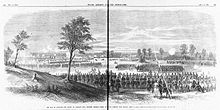9th Missouri Infantry Regiment
| 9th Missouri Infantry Regiment Clark's Missouri Infantry | |
|---|---|
| Active | November 16, 1862 to June 7, 1865 |
| Country | |
| Branch | |
| Type | Infantry |
| Size | 594 (December 1, 1862) |
| Engagements | American Civil War |
The 9th Missouri Infantry Regiment (originally Clark's Missouri Infantry) was an
Organization

The 9th Missouri Infantry Regiment originated when
Service history
1862
The unit, known as Clark's Missouri Infantry, was assigned to the brigade of
1863
On January 4, 1863, while the regiment was in the process of transferring to
Reorganization
On September 30, the Arkansas-raised companies of Clarkson's former Independent Ranger Battalion were transferred out of the regiment to form a new battalion and were replaced by six companies from the 8th Missouri Infantry Battalion.[11] Clark retained nominal command of the unit, although Richard H. Musser was appointed as lieutenant colonel of the regiment. Richard Gaines was the regiment's new major.[12] As of September 30, the regiment contained 10 companies, designated with the letters A–I and K; all of which were Missouri-raised.[12]
The new regiment was then assigned to the brigade of Brigadier General
1864–1865

On January 12, 1864, Clark was elevated to brigade command, and Musser replaced Clark as commander of the regiment.[b] On January 29, the regiment left Camp Bragg and moved to a location in Hempstead County, Arkansas. In March, the 9th Missouri Infantry began moving towards Shreveport, Louisiana, which it reached on March 25. Additionally, on the 25th, a new division was formed from Parsons' brigade and Clark's brigade; Parsons commanded the new entity. Parsons' division left Shreveport on April 3 to come to the aid of Major General Richard Taylor, who was resisting a Union advance up the Red River. The unit reached Taylor at Pleasant Hill, Louisiana on April 9.[14] At the Battle of Pleasant Hill later that day, Parsons' division was on the right of the Confederate line, and Clark's brigade was to the right of Parsons' other brigade, which was commanded Colonel Simon P. Burns.[15] The initial charge was successful, breaking through the line of a Union brigade and capturing two artillery batteries.[14] However, a Union counterattack hit Parsons' flank, and the Confederate attack broke, with the men retreating in disorder.[16] The 9th Missouri Infantry officially reported 113 casualties, although Musser later stated that he believed the true count was about 175 men.[14]
After Pleasant Hill, the unit moved north to confront Steele, whose Union force was occupying
Notes
References
- ^ a b c d e f McGhee 2008, p. 215.
- ^ McGhee 2008, pp. 214–215.
- ^ a b McGhee 2008, p. 214.
- ^ Shea 2009, p. 292.
- ^ Shea 2009, p. 217.
- ^ Shea 2009, pp. 227–228.
- ^ Shea 2009, pp. 233–234.
- ^ Shea 2009, pp. 234–238.
- ^ Shea 2009, p. 240.
- ^ McGhee 2008, pp. 215–216.
- ^ a b McGhee 2008, p. 216.
- ^ a b c McGhee 2008, p. 217.
- ^ McGhee 2008, pp. 217–218.
- ^ a b c McGhee 2008, p. 218.
- ^ Johnson 1993, pp. 154–155, 159.
- ^ Johnson 1993, pp. 160–162.
- ^ McGhee 2008, pp. 218–219.
- ^ Forsyth 2003, p. 194.
- ^ Forsyth 2003, p. 159.
- ^ Forsyth 2003, p. 162.
- ^ Forsyth 2003, pp. 164–165.
- ^ McGhee 2008, p. 219.
Sources
- Forsyth, Michael J. (2003). The Camden Expedition of 1864. Jefferson, North Carolina: McFarland & Company, Inc. ISBN 0-7864-1554-1.
- Johnson, Ludwell H. (1993). Red River Campaign: Politics and Cotton in the Civil War. Kent, Ohio: Kent State University Press. ISBN 0-87338-486-5.
- McGhee, James E. (2008). Guide to Missouri Confederate Regiments, 1861–1865. Fayetteville, Arkansas: University of Arkansas Press. ISBN 978-1-55728-870-7.
- Shea, William L. (2009). Fields of Blood: The Prairie Grove Campaign. Chapel Hill: University of North Carolina Press. ISBN 978-0-8078-3315-5.
